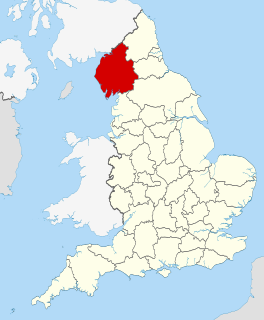
Beacon Fell is a fell located in the southern Lake District of England with an altitude of 836 feet (255 m). It is the subject of a chapter of Wainwright's book The Outlying Fells of Lakeland.
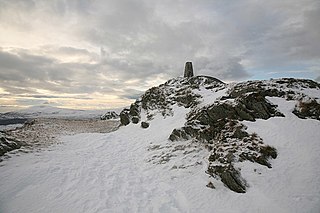
Caw is a hill in Cumbria, England, near the village of Seathwaite above the Duddon Valley, reaching 1,735 feet (529 m) and having a trig point at the summit. It is the subject of a chapter of Wainwright's book The Outlying Fells of Lakeland. His anticlockwise route from Seathwaite returns over Pikes at 1,520 feet (460 m) and Green Pikes at 1,350 feet (410 m).

School Knott is a hill in the Lake District, England, to the east of Windermere town, Cumbria. It is the subject of a chapter of Wainwright's book The Outlying Fells of Lakeland. His recommended route starts at Windermere railway station and includes Grandsire at 818 feet (249 m) and a nameless summit at 806 feet (246 m). The summit is at 760 feet (230 m) and offers a view of four sections of Windermere, the lake. It has a rocky outcrop but no trig point and, as reported by Wainwright, no cairn. Schoolknott Tarn is to the south-east of the summit.

Hesk Fell is a hill in the south-west of the English Lake District, between the Duddon Valley and Eskdale near Ulpha, Cumbria. It is the subject of a chapter of Wainwright's book The Outlying Fells of Lakeland. It reaches 1,566 feet (477 m) and Wainwright's route, an anticlockwise circuit from the Birker Fell road, also visits The Pike at 1,214 feet (370 m). Wainwright admits that the fell "has many shortcomings" and that the view of Scafell Pike and its neighbours is "the only reward for the ascent".

Stainton Pike is a hill in the English Lake District, near Waberthwaite, Cumbria. It is the subject of a chapter of Wainwright's book The Outlying Fells of Lakeland. It reaches 1,550 feet (470 m) and Wainwright's anticlockwise circuit also visits The Knott at 1,071 feet (326 m). The walk also passes the waterfall Rowantree Force and collection of ancient enclosures and hut circles known as Barnscar or City of Barnscar.

Scout Scar, also called Underbarrow Scar, is a hill in the English Lake District, west of Kendal, Cumbria and above the village of Underbarrow. It reaches 771 feet (235 m). Scout Scar is the subject of a chapter of Wainwright's book The Outlying Fells of Lakeland, but the summit he describes is a lower summit at 764 feet (233 m), 270m south of the highest point. Wainwright's anticlockwise recommended route also includes Cunswick Scar at 679 feet (207 m). The higher summit of Scout Scar has a topographic prominence of 109m and is thus classified as a HuMP, a hill with a prominence of at least 100m.

The Wasdale Horseshoe is a group of hills on the eastern fringe of the English Lake District, to the west of the A6, south of Shap, Cumbria. They surround the valley of Wasdale Beck, a tributary of Birk Beck and ultimately of the River Lune. The horseshoe is the subject of a chapter of Wainwright's book The Outlying Fells of Lakeland. This Wasdale should not be confused with the better known Wasdale, containing Wast Water, on the west of the Lake District.

The Naddle Horseshoe is a group of summits in the English Lake District, south of Mardale valley, Cumbria. It is the subject of a chapter of Wainwright's book The Outlying Fells of Lakeland.

Newton Fell is a hill in the English Lake District near High Newton, south east of Newby Bridge, Cumbria. It lies to the north east of the A590 road. It is the subject of a chapter of Wainwright's book The Outlying Fells of Lakeland. Wainwright describes two walks, to the summits he calls Newton Fell (north) at 780 feet (240 m) and Newton Fell (south) or Dixon Heights at 585 feet (178 m). There are no public rights of way to either summit, and he states that the walks should be done "by courtesy of the owners and tenants".
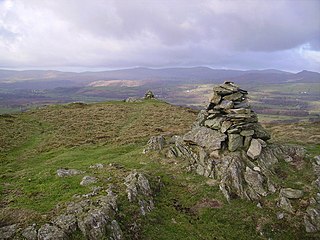
Blawith Knott is a hill in the south of the English Lake District, near Woodland, Cumbria. It is the subject of a chapter of Wainwright's book The Outlying Fells of Lakeland. It reaches 806 feet (246 m) and Wainwright's clockwise route from the fell road to the south-west also includes Tottlebank Height at 775 feet (236 m). He describes Blawith Knott as "a magnificent viewpoint", with both a panorama of Lake District fells to the north and, to the east to south, views which, on a clear day, include the Howgill Fells, Whernside and Ingleborough.
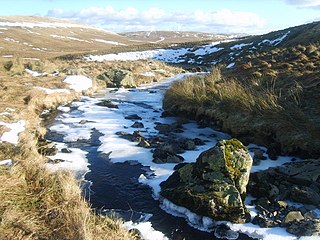
The Crookdale Horseshoe is a group of hills on the eastern edge of the English Lake District, in Cumbria, west of the A6 road. They are the subject of a chapter of Wainwright's book The Outlying Fells of Lakeland. Wainwright describes an anticlockwise walk starting along the valley of Crookdale Beck to reach Lord's Seat at 1,719 feet (524 m), and returning over Robin Hood at 1,613 feet (492 m) and High House Bank at 1,627 feet (496 m). As he points out, the ridge forming the northern part of the "horseshoe" is described in his Wasdale Horseshoe chapter.

Brant Fell is a hill in the English Lake District, near Bowness-on-Windermere, Cumbria. It is the subject of a chapter of Wainwright's book The Outlying Fells of Lakeland. It reaches 629 feet (192 m). Wainwright's route leaves Bowness along the path of the Dales Way, makes an anticlockwise loop over the viewpoint of Post Knott to the summit, and either returns along the Dales Way or follows a woodland path to Helm Road from where another viewpoint, Biskey Howe, is only a slight detour before continuing down Helm Road to Bowness. He commends its "fine prospect of Windermere".

Finsthwaite Heights is an upland area in the English Lake District, above Finsthwaite, Cumbria. It is the subject of a chapter of Wainwright's book The Outlying Fells of Lakeland. It reaches about 600 feet (180 m). Wainwright's walk starts from Newby Bridge, climbs through woodland passing a tower which has a 1799 inscription commemorating the Royal Navy, passes through the village, and climbs to the man-made tarns of Low Dam and High Dam. These were made to provide power for Stott Park Bobbin Mill. Wainwright says of his route: "Everywhere the surroundings are delightful. But this is not fellwalking."
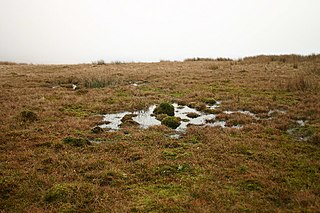
Ponsonby Fell is a hill in the west of the English Lake District, near Gosforth, Cumbria. It is the subject of a chapter of Wainwright's book The Outlying Fells of Lakeland. It reaches 1,020 feet (310 m), and Wainwright's route is an anticlockwise horseshoe starting at Gosforth, following the River Bleng before striking north for the summit, then descending to Wellington from where he recommends taking a bus back to Gosforth rather than walk along the A595 road.

Great Worm Crag is a hill in south west of the English Lake District, north of Ulpha, Cumbria. It is the subject of a chapter of Wainwright's book The Outlying Fells of Lakeland. It reaches 1,400 feet (430 m) and Wainwright's route is a clockwise circuit from the fell road between Ulpha and Eskdale Green.

The Wet Sleddale Horseshoe is an upland area in the English Lake District, around the Wet Sleddale Reservoir, Cumbria. It is the subject of a chapter of Wainwright's book The Outlying Fells of Lakeland. His walk starts at the reservoir dam and follows a clockwise circuit over Sleddale Pike at 1,659 feet (506 m), Great Saddle Crag at 1,850 feet (560 m) and Ulthwaite Rigg at 1,648 feet (502 m).

Hugill Fell is a hill in the English Lake District, near Staveley, Cumbria, on the west side of the Kentmere valley. It is the subject of a chapter of Wainwright's book The Outlying Fells of Lakeland. It reaches 840 feet (260 m) and Wainwright's walk is an ascent from Staveley and return on the same route. There is a cairn on the summit.

Irton Pike is a hill in the west of the English Lake District, near Santon Bridge, Cumbria. It is the subject of a chapter of Wainwright's book The Outlying Fells of Lakeland. It reaches 751 feet (229 m) and Wainwright's walk is an anticlockwise circuit from Irton Road station on the Ravenglass and Eskdale Railway, near Eskdale Green. He describes "this tiny top" as "a near-perfect solace for reminscences of past happy days on the higher fells", adding "Climb Irton Pike while ye may!"

Green Quarter Fell is an upland area in the east of the English Lake District, near Kentmere village, Cumbria. It is the subject of a chapter of Wainwright's book The Outlying Fells of Lakeland. Wainwright's walk is an anticlockwise circuit from Kentmere, reaching the summit of Hollow Moor at 1,394 feet (425 m) and a nameless summit at 1,370 feet (420 m) and making a detour to admire the tarn of Skeggles Water. He says that the walk offers: "... a perfectly-balanced and lovely view of upper Kentmere ... that cries aloud for a camera."

Latterbarrow is a hill in the English Lake District, east of Hawkshead, Cumbria. It is the subject of a chapter of Wainwright's book The Outlying Fells of Lakeland. It reaches 803 feet (245 m) and is surmounted by a monument, but Wainwright, unusually, makes no comment on the monument's age or purpose, merely mentioning this "... elegant obelisk being prominently in view from Hawkshead and the Ambleside district." He recommends an anticlockwise circuit from Colthouse, near Hawkshead, and describes it as "a circular walk needing little effort yet yielding much delight".


